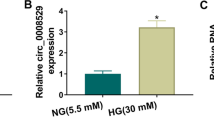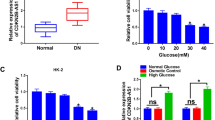Abstract
Advanced glycation end products (AGEs) are produced by glycosylation or oxidation of proteins and lipids and are tightly involved in the chronic kidney disease (CKD) process. Calpain 6 (CAPN6) is a non-classical calpain that has been reported to be overexpressed in CKD. This study aimed to explore the effects of AGEs in CKD progress and their correlation with CAPN6. AGEs production was measured using ELISA. The CCK-8 assay was used to test cell proliferation. mRNA and protein levels were tested using qRT-PCR and western blot. The progress of glycolysis was tested by calculating the ATP and ECAR content in HK-2 cells. The expression of AGEs and CAPN6 was significantly increased in patients with CKD3, CKD4, and CKD5. AGEs treatment inhibited cell proliferation and glycolysis and accelerated apoptosis. Additionally, CAPN6 knockdown effectively reversed the effects of AGEs in HK-2 cells. In addition, overexpressed CAPN6 played similar role to AGEs, which suppressed cell proliferation and glycolysis and facilitated apoptosis. Moreover, the administration of 2-DG, a glycolysis inhibitor, counteracted the effects of CAPN6 silencing in HK-2 cells. Mechanistically, CAPN6 interacts with NF-κB and PDTC reduced CAPN6 expression in HK-2 cells. This investigation revealed that AGEs facilitate CKD development in vitro by modulating the expression of CAPN6.






Similar content being viewed by others
Data availability
The datasets used and/or analyzed during the current study are available from the corresponding author upon reasonable request.
References
Bruck K, Stel VS, Gambaro G, Hallan S, Volzke H, Arnlov J et al (2016) CKD prevalence varies across the European general population. J Am Soc Nephrol 27:2135–2147
Chen L, Xiao D, Tang F, Gao H, Li X (2020) CAPN6 in disease: an emerging therapeutic target (Review). Int J Mol Med 46(5):1644–1652
D’Agati V, Schmidt AM (2010) RAGE and the pathogenesis of chronic kidney disease. Nat Rev Nephrol 6:352–360
Ding H, Jiang L, Xu J, Bai F, Zhou Y, Yuan Q et al (2017) Inhibiting aerobic glycolysis suppresses renal interstitial fibroblast activation and renal fibrosis. Am J Physiol Renal Physiol 313:F561–F575
Duan J, Wang C, Liu D, Qiao Y, Pan S, Jiang D et al (2019) Prevalence and risk factors of chronic kidney disease and diabetic kidney disease in Chinese rural residents: a cross-sectional survey. Sci Rep 9:10408
Egana-Gorrono L, Lopez-Diez R, Yepuri G, Ramirez LS, Reverdatto S, Gugger PF et al (2020) Receptor for advanced glycation end products (RAGE) and mechanisms and therapeutic opportunities in diabetes and cardiovascular disease: insights from human subjects and animal models. Front Cardiovasc Med 7:37
Guttula SV, Rao AA, Sridhar GR, Chakravarthy MS, Nageshwararo K, Rao PV (2010) Cluster analysis and phylogenetic relationship in biomarker identification of type 2 diabetes and nephropathy. Int J Diabetes Dev Ctries 30:52–56
Hill NR, Fatoba ST, Oke JL, Hirst JA, O’Callaghan CA, Lasserson DS et al (2016) Global prevalence of chronic kidney disease—a systematic review and meta-analysis. PLoS ONE 11:e0158765
Hori N, Hayashi H, Sugiyama Y (2011) Calpain-mediated cleavage negatively regulates the expression level of ABCG1. Atherosclerosis 215:383–391
Jandeleit-Dahm KA, Lassila M, Allen TJ (2005) Advanced glycation end products in diabetes-associated atherosclerosis and renal disease: interventional studies. Ann NY Acad Sci 1043:759–766
Jeon GY, Nam MH, Lee KW (2021) Inhibitory effect of caffeic acid on advanced glycation end product-induced renal fibrosis in vitro: A potential therapeutic target. J Food Sci 86:579–586
Jeong SY, Martchenko M, Cohen SN (2013) Calpain-dependent cytoskeletal rearrangement exploited for anthrax toxin endocytosis. Proc Natl Acad Sci USA 110:E4007–E4015
Jiang W, Zhao W, Ye F, Huang S, Wu Y, Chen H et al (2020) Inhibiting PKCbeta2 protects HK-2 cells against meglumine diatrizoate and AGEs-induced apoptosis and autophagy. Ann Transl Med 8:293
Jiao L, Wang S, Zheng Y, Wang N, Yang B, Wang D et al (2019) Betulinic acid suppresses breast cancer aerobic glycolysis via caveolin-1/NF-kappaB/c-Myc pathway. Biochem Pharmacol 161:149–162
Khan MI, Rath S, Adhami VM, Mukhtar H (2018) Hypoxia driven glycation: mechanisms and therapeutic opportunities. Semin Cancer Biol 49:75–82
Ko YA, Mohtat D, Suzuki M, Park AS, Izquierdo MC, Han SY, Kang HM, Si H, Hostetter T, Pullman JM, Fazzari M (2013) Cytosine methylation changes in enhancer regions of core pro-fibrotic genes characterize kidney fibrosis development. Genome Biol 14(10):R108
Koppe L, Nyam E, Vivot K, Manning Fox JE, Dai XQ, Nguyen BN et al (2016) Urea impairs beta cell glycolysis and insulin secretion in chronic kidney disease. J Clin Invest 126:3598–3612
Leonardis D, Basta G, Mallamaci F, Cutrupi S, Pizzini P, Tripepi R et al (2012) Circulating soluble receptor for advanced glycation end product (sRAGE) and left ventricular hypertrophy in patients with chronic kidney disease (CKD). Nutr Metab Cardiovasc Dis 22:748–755
Liu Y, Mei C, Sun L, Li X, Liu M, Wang L et al (2011) The PI3K-Akt pathway regulates calpain 6 expression, proliferation, and apoptosis. Cell Signal 23:827–836
Lozano R, Naghavi M, Foreman K, Lim S, Shibuya K, Aboyans V et al (2012) Global and regional mortality from 235 causes of death for 20 age groups in 1990 and 2010: a systematic analysis for the Global Burden of Disease Study 2010. Lancet 380:2095–2128
Lunt SY, Vander Heiden MG (2011) Aerobic glycolysis: meeting the metabolic requirements of cell proliferation. Annu Rev Cell Dev Biol 27:441–464
Mills KT, Xu Y, Zhang W, Bundy JD, Chen CS, Kelly TN et al (2015) A systematic analysis of worldwide population-based data on the global burden of chronic kidney disease in 2010. Kidney Int 88:950–957
Mitsnefes MM, Betoko A, Schneider MF, Salusky IB, Wolf MS, Juppner H et al (2018) FGF23 and left ventricular hypertrophy in children with CKD. Clin J Am Soc Nephrol 13:45–52
Miyazaki T, Taketomi Y, Takimoto M, Lei XF, Arita S, Kim-Kaneyama JR et al (2011) m-Calpain induction in vascular endothelial cells on human and mouse atheromas and its roles in VE-cadherin disorganization and atherosclerosis. Circulation 124:2522–2532
Perrone A, Giovino A, Benny J, Martinelli F (2020) Advanced glycation end products (AGEs): biochemistry, signaling, analytical methods, and epigenetic effects. Oxid Med Cell Longev 2020:3818196
Rabbani N, Thornalley PJ (2018) Advanced glycation end products in the pathogenesis of chronic kidney disease. Kidney Int 93:803–813
Rabbani N, Sebekova K, Sebekova K Jr, Heidland A, Thornalley PJ (2007) Accumulation of free adduct glycation, oxidation, and nitration products follows acute loss of renal function. Kidney Int 72:1113–1121
Riwanto M, Kapoor S, Rodriguez D, Edenhofer I, Segerer S, Wuthrich RP (2016) Inhibition of aerobic glycolysis attenuates disease progression in polycystic kidney disease. PLoS ONE 11:e0146654
Romagnani P, Remuzzi G, Glassock R, Levin A, Jager KJ, Tonelli M et al (2017) Chronic kidney disease. Nat Rev Dis Primers 3:17088
Ruiz HH, Ramasamy R, Schmidt AM (2020) Advanced glycation end products: building on the concept of the "Common Soil" in metabolic disease. Endocrinology 161(1):bqz006
Subramanian V, Uchida HA, Ijaz T, Moorleghen JJ, Howatt DA, Balakrishnan A (2012) Calpain inhibition attenuates angiotensin II-induced abdominal aortic aneurysms and atherosclerosis in low-density lipoprotein receptor-deficient mice. J Cardiovasc Pharmacol 59(1):66–76
Talmor-Barkan Y, Bernheim J, Green J, Benchetrit S, Rashid G (2011) Calcitriol counteracts endothelial cell pro-inflammatory processes in a chronic kidney disease-like environment. J Steroid Biochem Mol Biol 124:19–24
Thornalley PJ, Rabbani N (2014) Detection of oxidized and glycated proteins in clinical samples using mass spectrometry–a user’s perspective. Biochim Biophys Acta 1840:818–829
Tonami K, Kurihara Y, Aburatani H, Uchijima Y, Asano T, Kurihara H (2007) Calpain 6 is involved in microtubule stabilization and cytoskeletal organization. Mol Cell Biol 27:2548–2561
Tonami K, Hata S, Ojima K, Ono Y, Kurihara Y, Amano T et al (2013) Calpain-6 deficiency promotes skeletal muscle development and regeneration. PLoS Genet 9:e1003668
Tsubokawa D, Kikuchi T, Lee JM, Kusakabe T, Yamamoto Y, Maruyama H (2021) Venestatin from parasitic helminths interferes with receptor for advanced glycation end products (RAGE)-mediated immune responses to promote larval migration. PLoS Pathog 17:e1009649
Wang N, Chen W, Linsel-Nitschke P, Martinez LO, Agerholm-Larsen B, Silver DL et al (2003) A PEST sequence in ABCA1 regulates degradation by calpain protease and stabilization of ABCA1 by apoA-I. J Clin Investig 111:99–107
Wang T, Ning K, Sun X, Zhang C, Jin LF, Hua D (2018) Glycolysis is essential for chemoresistance induced by transient receptor potential channel C5 in colorectal cancer. BMC Cancer 18:207
Wang M, Li Y, Li S, Lv J (2022) Endothelial dysfunction and diabetic cardiomyopathy. Front Endocrinol (lausanne) 13:851941
Whitman IR, Feldman HI, Deo R (2012) CKD and sudden cardiac death: epidemiology, mechanisms, and therapeutic approaches. J Am Soc Nephrol 23:1929–1939
Xu Y, Jiang T, Wu C, Zhang Y (2020) CircAKT3 inhibits glycolysis balance in lung cancer cells by regulating miR-516b-5p/STAT3 to inhibit cisplatin sensitivity. Biotechnol Lett 42:1123–1135
Zenner ML, Helou YB, Deaton RJ, Sverdlov M, Wang H, Kajdacsy-Balla A et al (2022) Advanced glycation end-products (AGEs) are lower in prostate tumor tissue and inversely related to proportion of West African ancestry. Prostate 82:306–313
Zhang YY, Gu LJ, Zhu N, Wang L, Cai MC, Jia JS, Rong S, Yuan WJ (2021) Calpain 6 inhibits autophagy in inflammatory environments: A preliminary study on myoblasts and a chronic kidney disease rat model. Int J Mol Med 48(4):194
Zhu L, Sun Y, Wu Q, Zhang C, Ling J (2020) CAPN6 regulates uterine leiomyoma cell proliferation and apoptosis through the Rac1-dependent signaling pathway. Ann Clin Lab Sci 50(1):24–30
Funding
This research was supported by the Topic of Shanghai Health Commission (No. 202040026), The third batch of key disciplines of Traditional Chinese medicine in Jiading District, Shanghai (No. 2020-JDZYYZDXM-01), Jiangqiao town community Health service Center famous old Chinese medicine (school) studio (No. 2021MLZYLPLPGZS-09), and Shanghai Jiading District Health system "Jiading Medical Star" young talent training program scientific research project (2019JDJYXX008).
Author information
Authors and Affiliations
Contributions
MJ designed this project, participated in all experiments and revised the manuscript; YZ and HH performed the experiments and wrote the draft; YQ and QW participated in sample collection, analyzed the data, and edited the diagrams. All the authors contributed to the article and approved the submission of the definitive version.
Corresponding author
Ethics declarations
Conflict of interest
The authors report there are no competing interests to declare.
Ethics approval and consent to participate
This study was approved by the independent ethics committee of Shanghai YangPu district KongJiang Hospital and strictly obeyed the Declaration of Helsinki.
Additional information
Handling editor: Y. Su.
Publisher's Note
Springer Nature remains neutral with regard to jurisdictional claims in published maps and institutional affiliations.
Supplementary Information
Below is the link to the electronic supplementary material.

726_2023_3282_MOESM1_ESM.jpg
Supplementary file1Figure S1: Knockdown and overexpression of CAPN6 in human HK-2 cells. (A) and (B). qRT-PCR assay and western blot analysis were employed to confirm the transfection efficiency of shCAPN6 vector. (C) and (D). qRT-PCR assay and western blot analysis were employed to confirm the transfection efficiency of CAPN6 overexpression vector (JPG 87 KB)
Rights and permissions
Springer Nature or its licensor (e.g. a society or other partner) holds exclusive rights to this article under a publishing agreement with the author(s) or other rightsholder(s); author self-archiving of the accepted manuscript version of this article is solely governed by the terms of such publishing agreement and applicable law.
About this article
Cite this article
Zhang, Y., Han, H., Qian, Y. et al. Advanced glycation end products promote the progression of chronic kidney diseases by targeting calpain 6. Amino Acids 55, 903–912 (2023). https://doi.org/10.1007/s00726-023-03282-5
Received:
Accepted:
Published:
Issue Date:
DOI: https://doi.org/10.1007/s00726-023-03282-5




